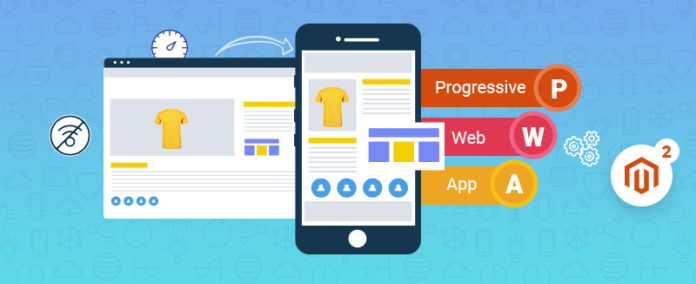With the bandwagon jump in the number of the population who prefer browsing on their mobile devices (exactly saying, around 3.5 billion people worldwide), it’s easy to conclude that there is a high dependency on such devices. Online businesses recognized this opportunity and endeavored to introduce new strategies to lead the online market. Their efforts result in the introduction of an impressive technology named Progressive Web Apps (PWA).
Nowadays, PWA is considered one of the most popular terms, and the reason behind this popularity is its outstanding benefits. Because there was a time when apps were considered the most convenient technology, but later, the hearts of users filled with it as they eat up a large amount of storage on their mobile devices. Therefore, the need also arises for the evolution of an advanced tool that can improve the UX. In simple words, there should be a technology that incorporates the features of both websites and apps, like Progressive Web Apps.
In this piece of context, we have discussed everything about the PWA, including its features, reason to develop, PWA tools, and a lot more. Take a look-
What is a PWA (Progressive Web App)?
Before we discuss the definition, let’s consider this example-
If you browse a particular website on your mobile browser, then you might encounter a pop-up asking you “Add to Home Screen.” If you choose the option, then the app automatically installs in the background without moving to the app store for the app download. It will install by itself. After the installation, you can access the app on your phone without requiring a browser. This amalgamation of both apps and websites refer to PWA (Progressive Web App).
The primary aim of this app is to provide a user with an app-like experience. Nowadays, companies find this technology a perfect one as it includes several advanced features that are transforming the user’s browsing experience.
Features of PWA-
PWA incorporates advanced features, making it a reliable technology for numerous companies nowadays. Check it out-
- Progressive: By name, one can easily conclude that PWA enhances progressively, as it can be worked on any device.
- Highly-Responsive: Yes, Progressive Web Apps are responsive too. It fits easily as per the structure and screen size of the device.
- App-Like Experience: Progressive Web apps provide the user with an app-like experience. It looks like a native app and incorporates the app features that require minimal page refreshes.
- Work Offline: Such web apps have an impressive ability to perform well in low connectivity and even offline. This is one of the favorite characteristics which make it a perfect choice of technology.
- Installable: Such apps can be installed on screens of several devices. It even performs very well, achieving the same efficiency goals with their absolute features.
- Safe: Because the app is hosted over HTTPS to prevent online attacks, so it is safe to use. It makes the user experience a flawless one.
Why Should You Develop a Progressive Web App?
Why should one say “Yes” to Progressive Web Apps? How can it be helpful for you? Here we have covered the answer to all your questions-
- The native apps involve many steps for installation. Following such steps for app installation decline the user experience. On the other hand, progressive web apps can be easily installed without going through so many steps and can be used immediately, enhancing the user experience as well.
- PWA increases the efficiency of the overall performance of your piece of software. Because the application downloads in the background from the web, it will take less time to load than the apps downloaded from the app store.
- Progressive Web Apps are text-based code, so it is smaller than a native application’s installation file. So, it requires low data to install as well as run on your device.
How to Get Started with Progressive Web App (PWA)?
There are innumerable benefits of Progressive Web Apps that also make many companies adopt it. If you also want to kick-off the web app, then consider the below-listed points. Here are a few methods that are ideal for implementing PWA.
a) From ground zero
Implementing the PWA on ground zero or while building a website is a smart and sensible move. By doing this, you can push PWA forward with AMP, service workers, App shell, and Web Manifest. Another advantage is that this practice also increases the conversion rate for new users. One such example is AliExpress, who revamped their website as PWA, which increases the conversion rate by 104 percent, gained much 2x traffic, and a 74 percent increase in total time spent across all browsers.
b) A simple version
If building from scratch is not your choice, then you can build a simple version of a website focusing on a few features. In such a case, the primary focus revolves around delivering a fast and reliable experience to end-users. Taking an example of AirBerlin, which only focused on the post-booking experience in their PWA. After checking in, the passenger can easily get access to the journey details and boarding pass even without the internet.
Progressive Web App Development Tools
Below we have listed some of the popular tools used for the effective and efficient development of PWA technology.
1. Knockout
The first tool on our list is knockout, a free Javascript tool that provides complete assistance to developers in terms of building responsive displays. This tool even makes the process of changing the UI of the program simple for developers and technicians.
2. PWA.rocks
Second, PWA rock is another impressive PWA development tool flooded with innovative web app illustrations, making it a perfect tool to be utilized by developers and entrepreneurs.
3. Web App Manifest
Web App Manifest is a great tool that showcases the overall working of PWA. It helps in understanding the program in the best way possible. If we talk about its features, then it includes the appearance of dwelling screen icons, display orientation, and how a page ought to be loaded first.
4. Webpack
The list of best Progressive Web App tools is incomplete without the Webpack, a reliable tool to use in collecting all of your JS resources in one place (no matter if it is coding or noncoding data). When it comes to developing the frontend, then Webpack is always considered the best. Not only this, but it also makes it easy for developers to utilize two plugins. The best part about this tool is that one can use it with complex projects. It can handle difficult tasks.
5. PowerBuilder
The last PWA’s tool on our list is Powerbuilder, which is used with ready-made web solutions. The use of the tool is super-easy. It involves the development of manifest (a blog of metadata), which programmers do, adding the title of the website, its detailed description, and an icon to use. It also offers flexibility. Yes, you can change many details, such as the screen orientation of your PWA, its terminology, and color as per your taste.
PWAs Have Several Benefits Over Mobile Apps
1. Take Less Device Space Than a Traditional App
Yes, this is true. PWA apps take less space as compared to traditional apps. Mobile apps need to be downloaded from app stores, whereas PWAs are hosted on web servers, hence doesn’t require much space on your device.
2. They Update Themselves Independently
Progressive web apps are updated independently. There is no need to visit the App Store to download the updates. It also saves your time, as you don’t have to wait while the updates are installed.
3. Similar Functionality Like Native Apps
Progressive Web apps work in the same way as native apps function. The thing which makes PWAs a better choice than native apps is its capability to function without relying upon an internet browser. Not only this, its responsive web design feature gives more reasons to choose this advanced technology and enhance the user browsing experience as well. From total screen display to splash display, push notifications to push alarms, it includes several impressive features that sometimes a native app fails to offer.
Several Companies Showed Their High-Interest in PWA Technology
Progressive Web App is shaping up the online businesses with its best features that a native app failed to do. There has been a slight shift noticed in the interest of several businesses towards the implementation of PWA Solution. Some of them are listed below-
- BookMyShow
- Uber
- Twitter Lite
- Forbes
- Alibaba
- Olx
And many other companies are finding this PWA technology an ideal one to generate more revenue and engagement on their platforms. In short, the future of PWA apps is bright.
Final Thoughts
This blog post has covered everything you need to know about Progressive Web Apps (PWA). From its several benefits over native apps to several PWA tools, we have listed everything above that will help you in the journey of achieving success in the online market.







